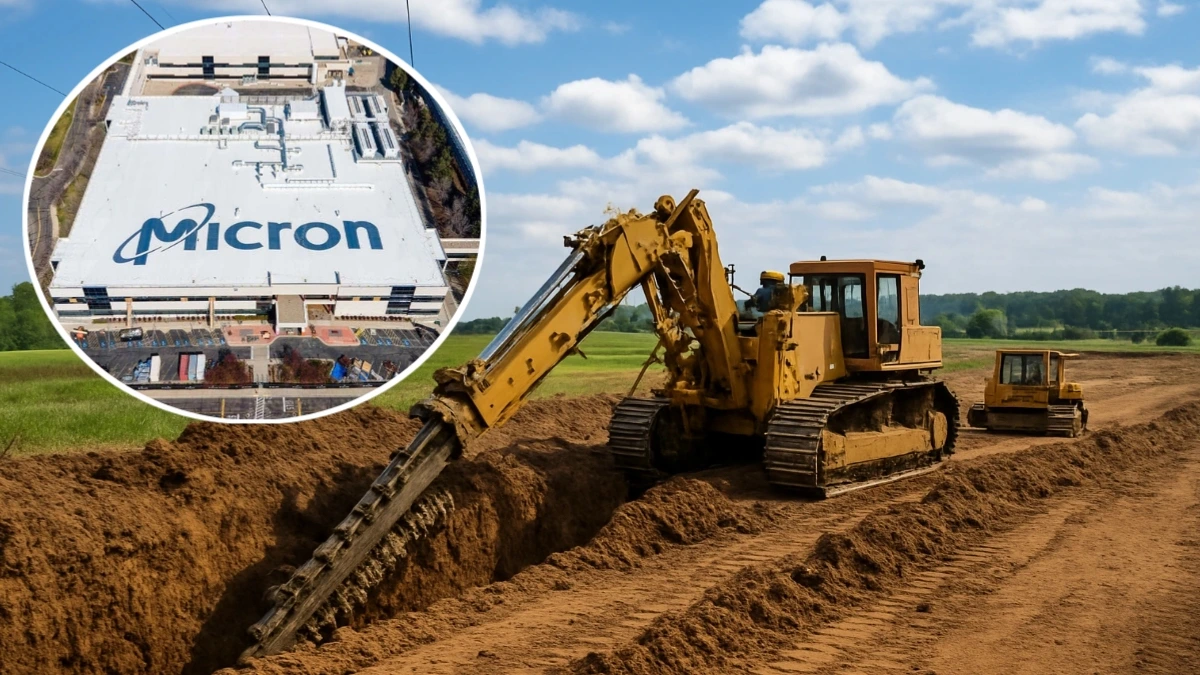NEW YORK — New York state regulators have approved a new underground transmission line to supply power to Micron Technology’s proposed $100 billion semiconductor manufacturing complex in Onondaga County, Governor Kathy Hochul announced Thursday.
The two mile, 345 kilovolt transmission line will connect the existing Clay substation to the site of Micron’s planned megafab, marking a significant milestone in what state officials have called the largest private investment in New York’s history.
“This project is set to transform Central New York and we’re moving quickly ahead with all due speed and deliberation,” Hochul said in a statement.
The approval by the New York State Public Service Commission represents one of the last key infrastructure steps before construction begins on Micron’s advanced semiconductor facility, which was first announced in 2022.
The Idaho based chipmaker selected Central New York after signing a long term economic development agreement with the state, which includes substantial tax incentives and infrastructure commitments.
Under the agreement, Micron will invest up to $100 billion over the next 20 years to build and expand a manufacturing complex that could produce up to one quarter of all semiconductors made in the United States by 2030.
State officials have hailed the project as a cornerstone of the US effort to bring semiconductor production back from Asia, in line with federal initiatives under the CHIPS and Science Act aimed at boosting domestic chip manufacturing.

“This isn’t just a New York project it’s part of a national strategy to ensure America leads in semiconductor innovation,” said State Economic Development Commissioner Hope Knight. “The infrastructure we’re approving today is what makes those ambitions possible.”
Energy and infrastructure experts say the transmission line approval underscores the scale and complexity of supporting modern semiconductor manufacturing.
Chip fabrication plants known as fabs consume vast amounts of electricity and water, making reliable power supply a critical factor.
“Micron’s facility will require the kind of high voltage stability that only dedicated infrastructure can guarantee,” said Dr. Alan Pierce, an energy systems professor at Syracuse University.
“The state’s investment in this power line shows an understanding that advanced manufacturing cannot thrive without equally advanced energy infrastructure.”
Pierce noted that similar infrastructure buildouts have accompanied large scale chip plants in Arizona, Texas, and Ohio.
“It’s a global competition for capacity,” he said. “States that can offer reliable energy, transportation, and workforce pipelines will be the ones that win.”
The Micron project is projected to create more than 50,000 jobs over the next two decades, including approximately 9,000 direct positions at the company’s New York operations, according to Hochul’s office.
The average annual wage for these positions is expected to exceed $100,000. By comparison, Intel’s semiconductor investments in Ohio valued at roughly $28 billion are expected to generate about 20,000 jobs.
Taiwan Semiconductor Manufacturing Co.’s Arizona facility, pegged at $40 billion, is projected to employ about 4,500 workers directly.
Micron’s $100 billion commitment surpasses both projects in scale and ambition, making it one of the largest private sector investments in US manufacturing history.
The commission also approved environmental and construction plans for the first phase of the project, including the eastern expansion of the Clay substation and the installation of new transmission equipment linking it to the Micron facility.
In Onondaga County, residents and local business leaders have expressed cautious optimism about the project’s potential.
“This region has waited decades for something like this,” said Kevin O’Malley, owner of a logistics firm in Syracuse. “If Micron delivers on its promises, it could change the entire economic landscape of Central New York.”
However, some community members have raised concerns about potential environmental impacts and local infrastructure strain.
“We want the jobs and growth, but it has to be sustainable,” said Maria Lopez, a member of the Central New York Environmental Coalition.
“The state needs to ensure that increased industrial activity doesn’t compromise our air and water quality.” County Executive Ryan McMahon said local officials are working closely with both Micron and state agencies to address those concerns.
“This project is too important to get wrong,” he said. “We’re building a model for how high tech manufacturing and environmental responsibility can coexist.” Micron expects to begin site preparation in early 2026, with full scale chip production targeted for the early 2030s.
The company plans to use the New York site to produce advanced memory chips critical to data centers, artificial intelligence, and automotive technology.
Hochul has described the project as central to her administration’s broader strategy to make New York a leader in next generation manufacturing and technology innovation.
“This is the beginning of a long term transformation,” Hochul said. “From education and workforce training to clean energy and housing, we’re aligning state priorities to ensure that Central New York becomes the heart of America’s semiconductor future.”
Federal officials have also taken note. The US Department of Commerce has identified Micron’s investment as a potential recipient of incentives under the CHIPS Act, which offers billions in grants and tax credits to companies that expand domestic chip production.
With Thursday’s approval of the transmission line, New York has cleared one of the most critical early hurdles in Micron’s $100 billion semiconductor expansion plan.
The decision brings the state a step closer to realizing its vision of becoming a key hub in the US semiconductor supply chain one built on advanced infrastructure, skilled labor, and long term economic growth.
As construction begins to take shape, the Micron megafab stands poised to redefine both the regional economy and America’s broader technological landscape.

